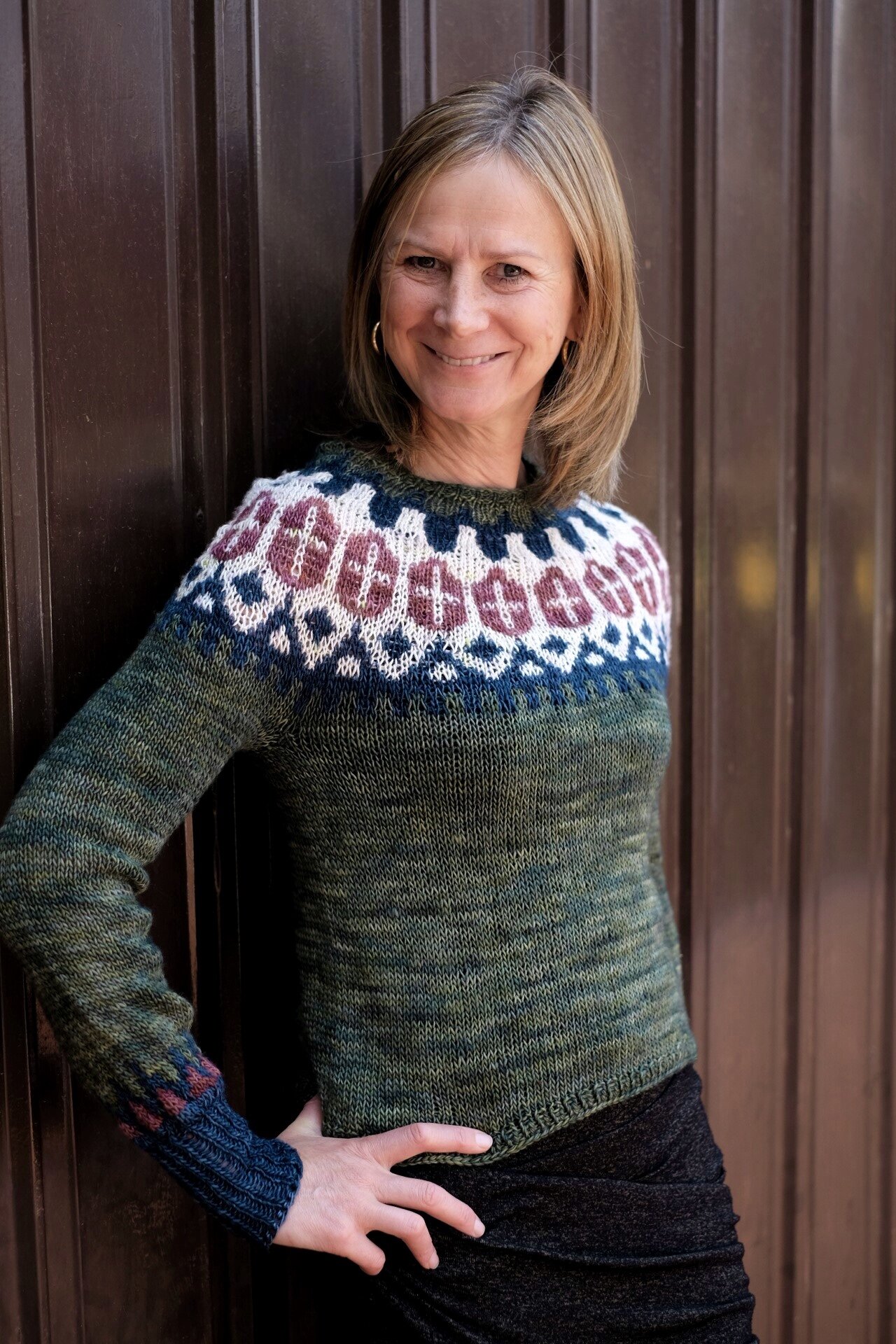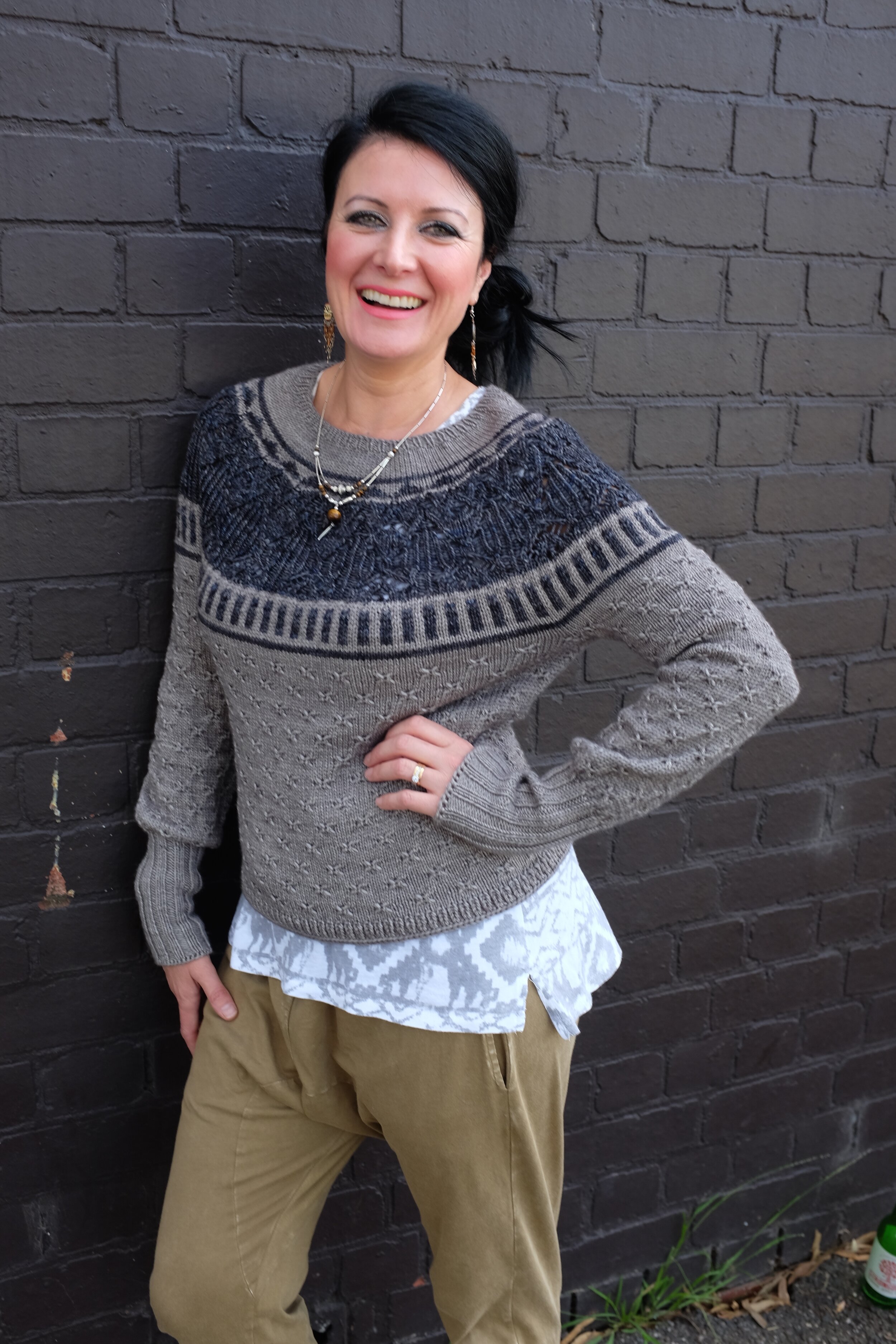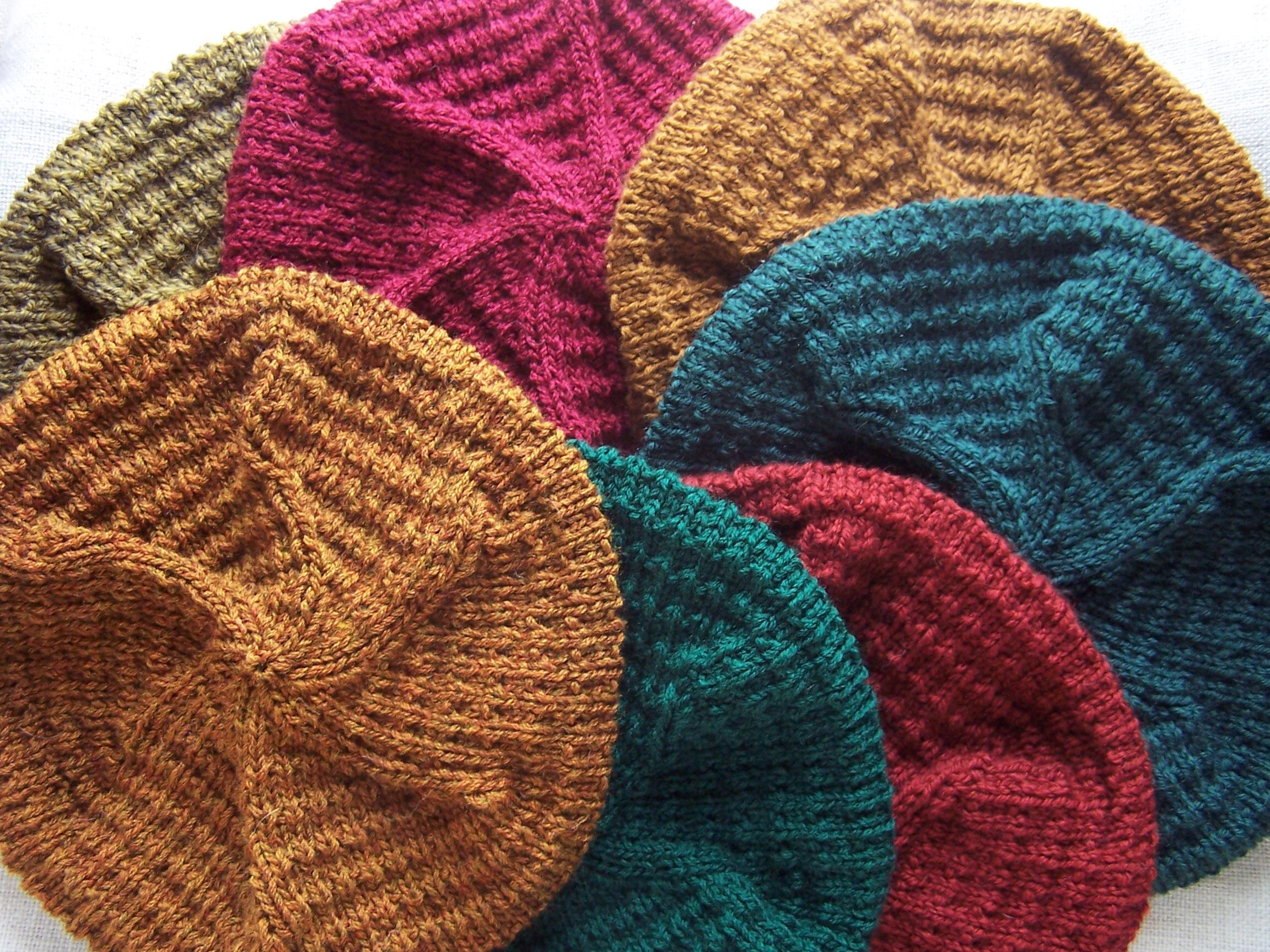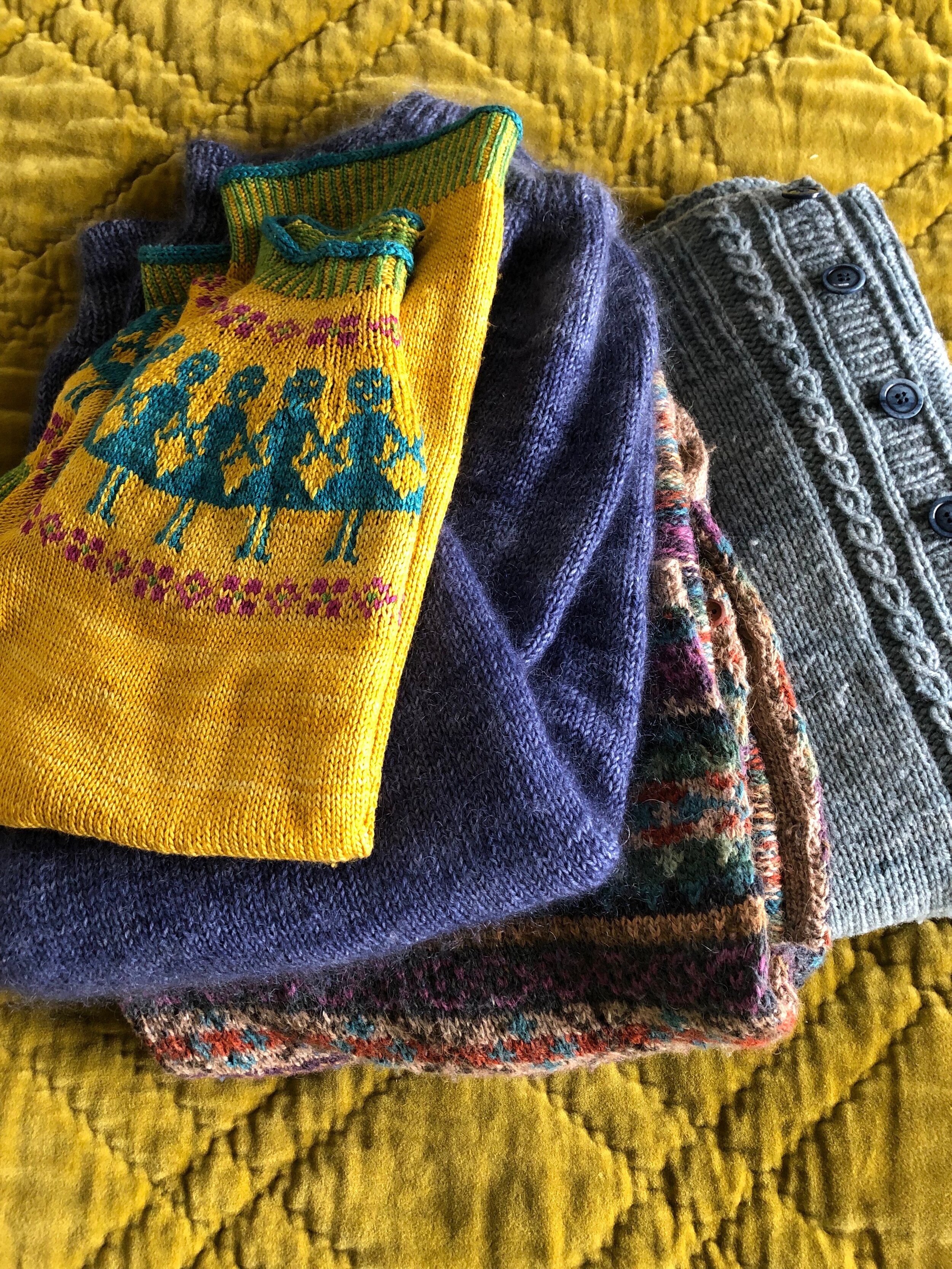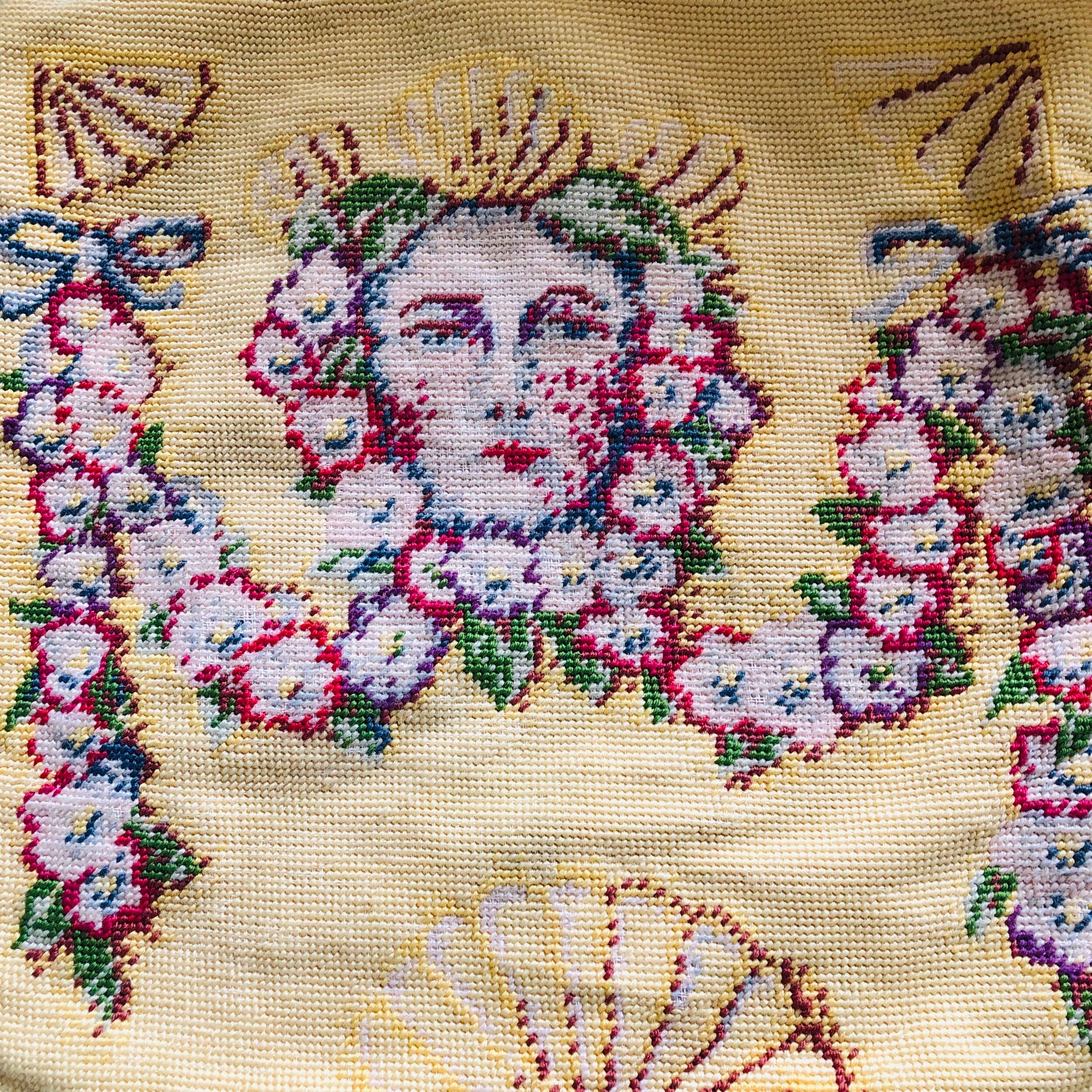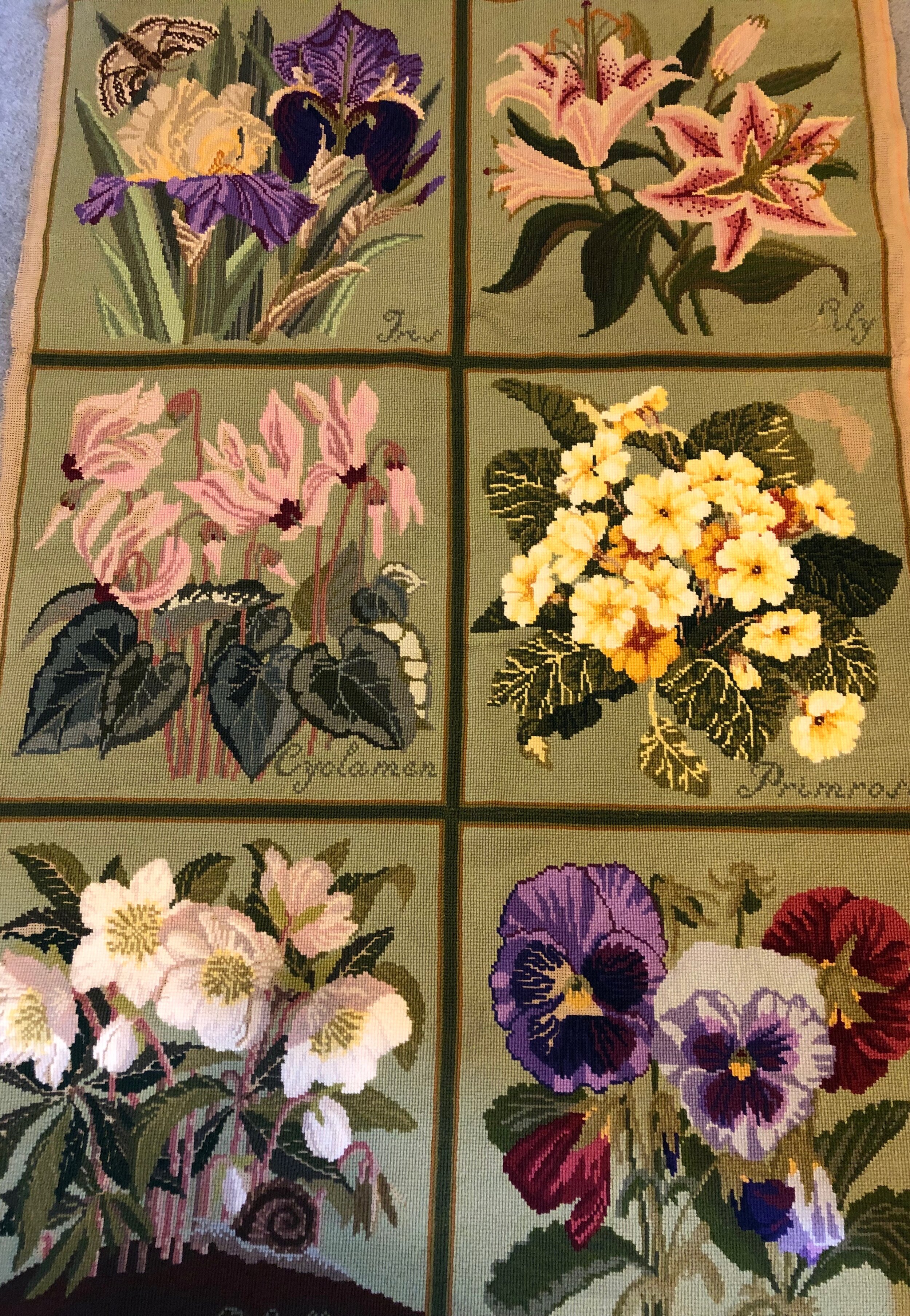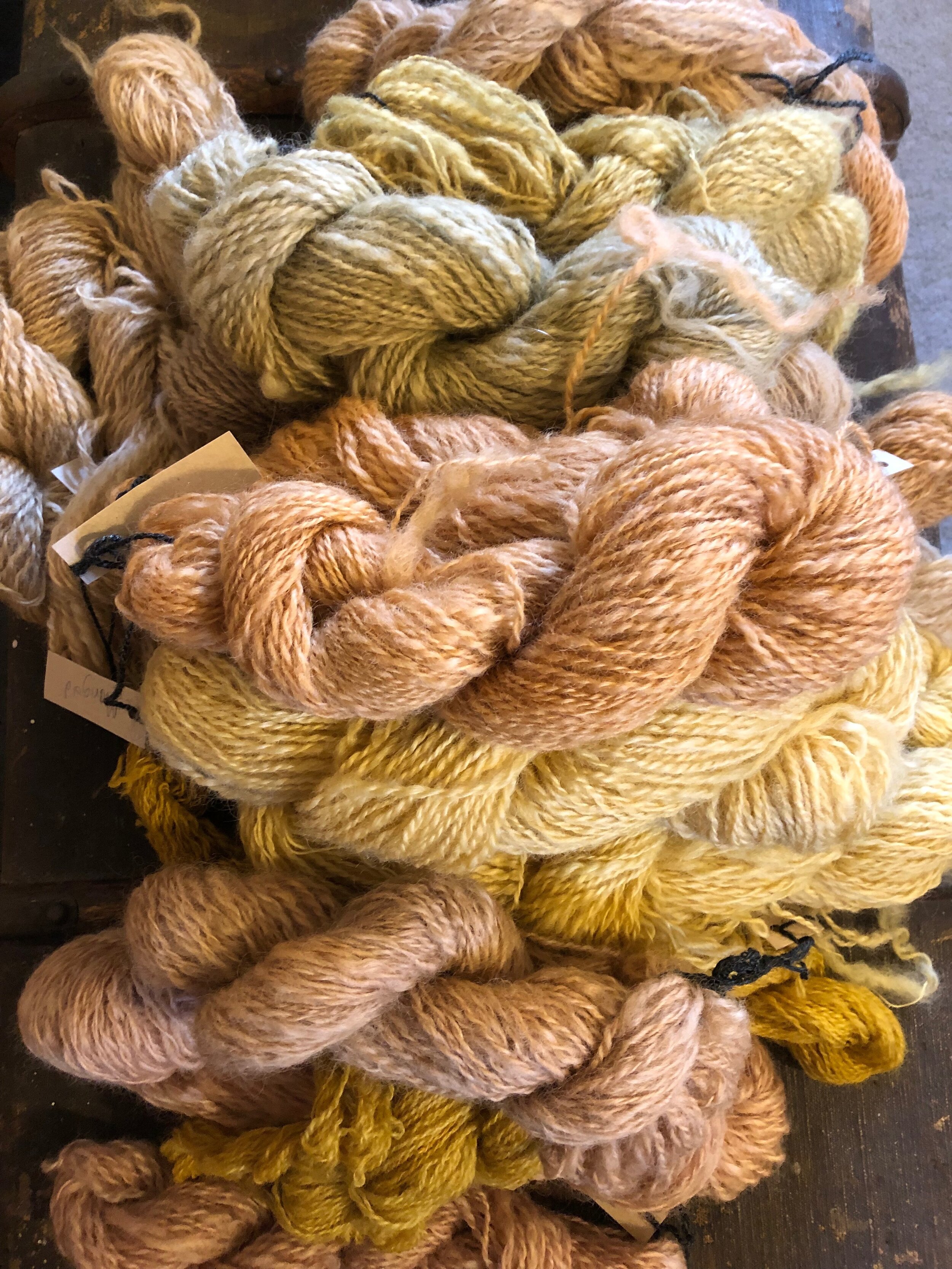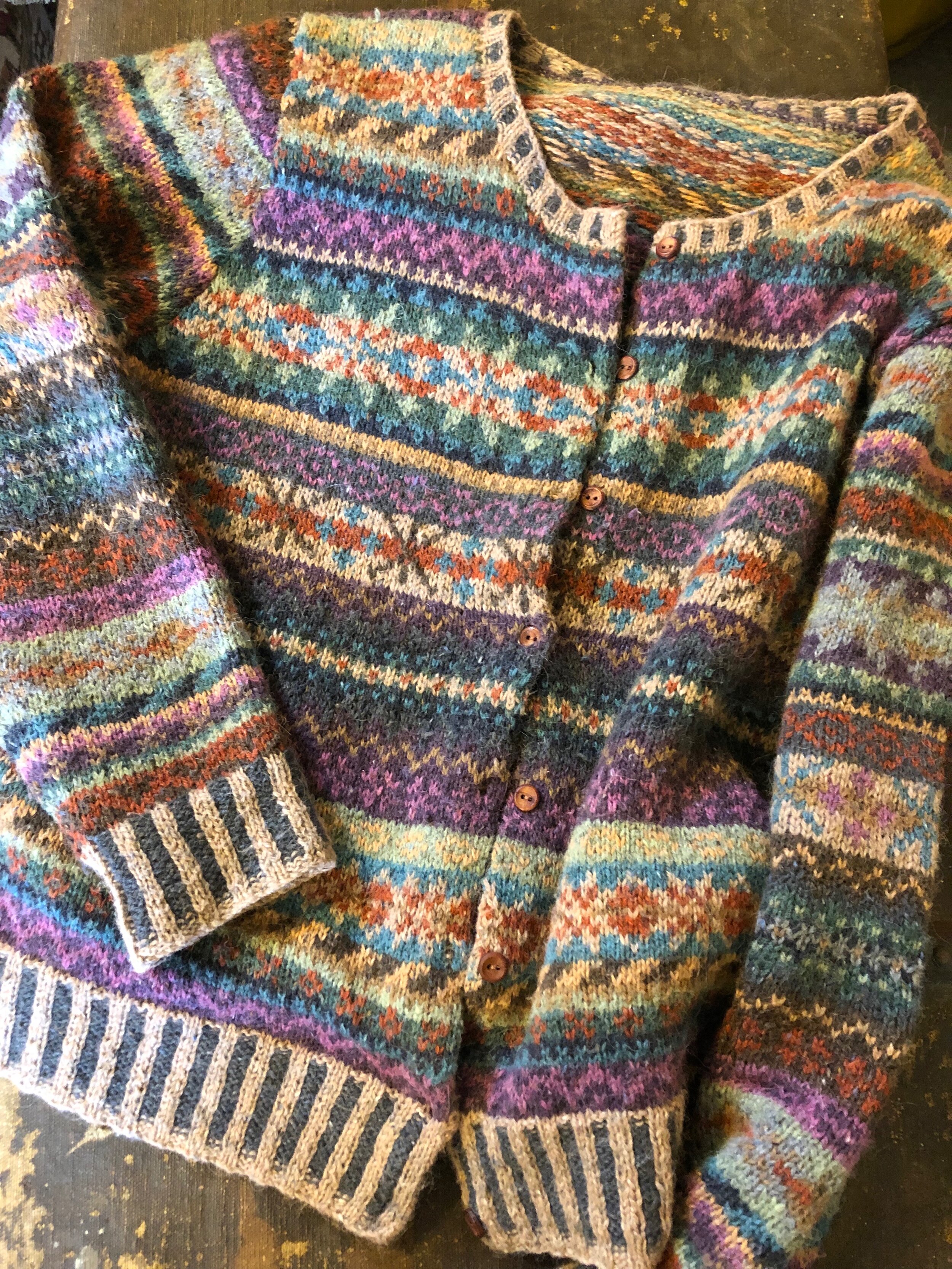Kelly O’Day - aka Miss Click Clack - in Melbourne black
We were first drawn to Miss Click Clack / Kelly O’Day’s beautiful yarn in part by her gorgeous, moody blacks and dark tones which to us evoke Melbourne’s dark laneways, changeable weather (like Wellington!) and chic fashionistas. If Sydney is sparkle and white, Melbourne is cool and black. At least that’s how it seems to us from a distance! But digging into the story of Miss Click Clack was even more fascinating – as her Instagram profile tells us, she had cancer twice. Her relentlessly positive attitude, her amazing photography from wild spots around the world and around Australia and her (naturally) lovely handknits (and oh, the socks) compelled us to write to her to learn more. She kindly obliged with the interview below.
NEWTOWN HOUSE: Please tell us how you got started yarn wrangling / dyeing / knitting ... and what was the work you were doing before you started working with wool?
Precocious and clever crafting: Fibre love started early for Kelly O’Day.
KELLY O’DAY: Craft insinuated itself into my life at an early age. When I was a pre-schooler a sewing kit was offered to me by way of a bribe if I’d cut my hair for school. I succumbed to the lure, but yarn was already my jam. I’d learnt to knit at four, and in prep (my first year of school) I completely rocked (over same haircut) an apricot pixie hat I’d made from a stockinette rectangle folded and seamed on one edge, affixed by a couple of garter stitch straps. Then when I was seven my mum learnt to crochet, and she taught me. I liked it. A lot. In Year 5 I crocheted myself so many garments (seven) that my teacher asked if I’d make something for her. But my dad, protective of his prodigious spawn, said no. These days we would have seen the opportunity – he’d have been be my agent, contracts would’ve been drawn replete with IP clauses and stipulations of hefty remuneration, I’d have had my own tweeny podcast, and, of course, there’d be those segments on daytime TV where I’d have looked completely darling in some groovy, self-crafted ‘70s ensemble, still sporting most of my milk teeth. But being the parents of a craftily precocious child also had its downside. At ten, in true enfant terrible style, I threw my first hissy fit because I had to settle for a ‘lesser’ pure wool yarn than the ‘superior’ one I wanted for a granny square tank-top. I’d become a yarn snob. The template for adult life had been set.
Yarn and I hung out right through high school and right through uni. When I set off to work at a cytogenetics lab in a large teaching hospital my knitting bag jumped into the car and rode shotgun.
The foray into crafty retail came late in my working career. I was knitting during work breaks and one day realised that I had a stupid number of hand-knitted accessories lying idle. So I started side-hustling under the brand ‘Miss Click Clack’. Things took off and I sold hundreds and hundreds of my Smith Street Beret (sounds kind of OCD now that I put that in print…). It was always fun to cruise up and down Smith Street Collingwood, or Brunswick Street Fitzroy (two happening precincts) and count them off, and secretly snap the occasional photo (sounds kind of creepy now that I put that in print…). I wanted to make berets in colours I couldn’t find so yarn dyeing seemed the logical next step. I’d also started buying hand-dyed sock yarn which had awakened something big in me. Lightbulb big. Epiphany big. I want-to-do-it-too big. I began to dabble, but was curtailed from running with it while working, so there was a hiatus of several years before ‘Miss Click Clack Yarn Dyer’ hit the retail scene in a meaningful way.
NH: Where did you get the idea for Miss Click Clack, and how challenging was it for you starting out? And where did you get the name Miss Click Clack?
Miss Click Clack’s moody beauties
KO: I appropriated part of the ‘Miss Click Clack’ name from a knitting ad that used to be on the telly a million years ago. It had a breathy, onomatopoeic ‘click clack’ voiceover which, over the years, would pop in and out of my consciousness until I eventually robbed it and became ‘Miss Click Clack’. It was only after I quit my job following a cancer diagnosis that Miss Click Clack took a jump to the right and morphed into the yarn dyer that most of you are familiar with. Yarn dyeing was supposed to be a ‘gentle hobby that paid for itself’ while I considered my new post-cancer life and I set modest production targets. But after some early attention on social media things went BANG so I cranked things up, dyeing on my kitchen stove full time between meals. I think I was lucky enough to be in the right place at the right time with a product that filled a hole. Melbourne seemed to be gagging for a local dyer who understood her urbane, moody aesthetic - her love of black, charcoal, navy, and colours shot with grey – with the occasional need for a punchy colour accent. Of course, my yarn sells everywhere – not just here in my hometown - and I have many loyal customers from myriad climes (including NZ!) so there’s a lot of what I like to call ‘Melbourne taste’ out there. Of course, it might really just be urbane-taste-in-a-temperate-climate! But whatever the truth, I’ve claimed the palette for Melbourne, as I’m not one for letting the truth get in the way of a good story!
NH: Tell us a bit about your range of Melbourne blacks - they're glorious. But what is it about Melburnians and black? And what are your primary inspirations for your colourways?
KO: The colourway ‘Melbourne Black’ is a moody blue-leaning charcoal which pays homage to both Melbourne’s iconic bluestone buildings, and her love of peri-black fashion. Melburnians love boots, and denim, and love to layer. They love wearing eclectic contemporary brands with vintage pieces, to which colour pops are added via a scarf or beanie. So the deliciously peri-black Melbourne Black went off like a bomb. I was rapt. I love my hometown and most of my yarn bases have some sort of Melbourne angle to their name (for example, ‘Bearbrass,’ the name of my BFL base, was one of the early name contenders for Melbourne before ‘Melbourne’ got the official gong). It’s been important to me to keep the Melbourne identity and to not lose that connection to the generous community that put me on the yarn-map in the first place.
Kelly in the tundra wearing a raspberry Rikke hat
NH: How do you spend your days, these days?
KO: If knitting hundreds of the same beret wasn’t a sufficiently illuminating glimpse into an aspect of my personality then let me be explicit: when struck by a passion I can be obsessive. And dyeing yarn became a passion which became obsessive - to the detriment of my well-being on occasion. But five-plus years down the track (I don’t like to rush things) I’m happy to report that I’ve finally found a work-life balance that works. I’m reading again, seeing family and friends more often, having ‘date-days’ with my husband, keeping up with my daily walks, and planning to get down-and-dirty doing conservation work on a bush block we’ve just bought. Sadly, dear husband, there still isn’t time for housework. 😉
So, yes, I am still dyeing, but dyeing less. But when I do want to chuck a bit of colour on some yarn I work to a three days’ rhythm. I studiously made a list of everything I do over these three days in the first draft of the answer to this question, but by the end I’d chewed through half an A4 page and my eyes had completely glazed over and rolled back into my head. So I will spare you the excruciating minutiae of being a solo yarn-dyer dyeing between meals on her kitchen stove. Instead I will tell you that in each day there are about two hours of ‘fun’ (dyeing/admiring) and eight hours (yes, the days can be long) of ‘un-fun’. Dyers can look so glamourous in public settings, surrounded by their delicious work. But you never see the pot-scrubbing, the back-breaking rinsing of yarn in the bathtub, the standing in queues at the post office, and the violence perpetrated against printers that spit the dummy when orders need to be printed and shipped. And my finger-tips – perennially wrinkled – I always fail the fingerprint test when entering the US.
NH: What inspires you? And which aspects of your work do you most enjoy? And how do you power through the less-fun parts?
KO: When I was fifteen my Home Group teacher gave me Peter Bowler’s The Superior Person’s Little Book of Words, confirming absolutely my (unspoken) self-estimation that I was, indeed, a Superior Person. I then proceeded to shoehorn my (now even more) Superior Lexicon into essays, much to the amusement of other teachers, while haughtily poo-pooing snorts of derision from classmates. Which is all quite a circumambagious (ahem) way of saying that I have loved words and language from a very early age and that often a colourway name comes to me before the actual colourway. In fact I keep a running list of prospective names which I augment (because the list never reduces) as inspiration strikes. I have colourways that are single words (‘Spodumene’, ‘Petrichor’); an entire range inspired by bears (‘Bear Hug’, ‘Bear Market’, ‘There’s A Bear in There’); another inspired by ponies (‘Show Pony’, ‘The Dappled Pony’, ‘The Felicitous Filly’); names inspired by pop culture and catchcries (‘Favourite 501s’, ‘Fake News’, ‘Houston, We Have a Problem’, ‘You’re Not the Boss of Me’); by songs and music (‘Brass in Pocket’, ‘We Got Married in a Fever’, ‘Ring of Fire’); and - because I like to show off - the occasional Shakespearian reference including ‘Fair Verona’, with ‘Posh Boy’ and ‘Poncing Pufflington Pants’ inspired by the “Upstart Crow” TV series). Occasionally the inverse happens and I am struck with Colourway Name Block which makes me very crabby because Superior Persons ought to be immune from such lapses. Nevertheless these little word games and pun plays are fun, and one of the ways I power through the many ‘less fun parts’.
That, and dopamine.
Stripey socks
Apparently, every time an online sale notification pops up on my phone a big, juicy squirt of dopamine hits my brain’s reward centre. I guess it’s this addiction to the ‘hit’ that keeps many microbusinesses (including mine) ticking over even when the physical work is demanding and the financial remuneration modest. It certainly explains a lot of my extreme behaviours (the more I dye the more I sell and the more hits I get!). I now appreciate the importance of enforcing a sensible work/life balance. But while all that brain chemistry stuff is going on unconsciously, consciously I also derive a lot of pleasure from the aesthetic of a dyed skein of yarn (I can admire a new colourway for days!) and then get an enormous buzz seeing it crafted into something wonderful by a customer. These are the things that make it all worthwhile. That and the friends I’ve made. The community has been abundantly generous with its love.
NH: Your Instagram profile is fascinating - you talk about being an aspiring flaneuse (a concept I am completely in line with), a lapsed cytogeneticist and that you once had cancer twice. We'd be grateful to hear as much of what sits behind those lines as you're comfortable sharing.
KO: Oh I could have listed many more things (failed novelist! occasional twitcher! champion of the apostrophe!) but I was limited by the number of characters in Instagram’s bio field which might be just as well for the reading pleasure of your lovely audience!
Aspiring Flaneuse: ‘aspiring’ because there is certain sartorial comportment that goes with being a proper Flaneuse which I’m unlikely to achieve in leisurewear. But I’ve been a street explorer forever (albeit propelled by a bike as a kid). My favourite period of nearly proper ‘flaneusing’ (should that be a word) was in my 20s and 30s when I lived in inner Melbourne. I would watch the people - what they were doing, what they were wearing, how they were living - all the while pondering the big questions: what it means to be human (which decisions are free, and which are pre-ordained, hard-wired), how we live together, what drives our need for personal space, and what are the ways we express either our individuality, or allegiance to a tribe (although I confess that in my current suburban domicile I’m largely perplexed and preoccupied by the human need to exact periodic domination over a patch of lawn with a violent machine). I also love to walk the laneways - the public spaces that most people don’t stop to explore - the service network of micro-streets that run behind houses and businesses. In fact, I have a yarn base that has a twist which reminds me of the bluestone pitchers that pave many of Melbourne’s laneways. I named it ‘Nightman’s Highway’, a nod to the forgotten ‘nightman’ and his weekly tending of the household ‘thunderbox’ via these laneways (yes, #worldsworstjob). So you see, that flaneusal (should that also be a word!) part of me has percolated into my yarn dyeing business!
A coffee break from the dye pots
‘Lapsed cytogeneticst’: I’m loathe to divorce myself from the moniker ‘cytogeneticist’ as it was my identity for decades, so ‘lapsed’ is our gentle separation.
‘I once had cancer twice’: one day I left work early to have a mammogram, and I never went back. In the process of characterising one cancer, a second and different cancer was found. Two different cancers, one episode of cancer surgery and treatment. It was very efficient of me.
NH: What is ahead for Miss Click Clack?
KO: I have no plans to crank up production, so perhaps it’s time for Miss Click Clack The Book?! My friends will tell you that at any one time there is the plot a novel in my head! As Miss Click Clack I’ve accrued an excellent stockpile of fibre industry stories – some related to the warm and diverse yarn-addicted friends I’ve made along the way, others to the cunning and devious ways of villainous (I just wanted to use that word!) rival dyers – stories ripe for comedic exploitation by some sassy author! Just between you (and your x-thousand readers) and me I’d love to be that sassy author, but, sadly, I procrastinate more than ‘do’, and there is a chaos in my head these days (I blame my BC meds but my husband tells me I’ve always been scatty) that makes it difficult to corral those thoughts into something cohesive on a computer screen. But many will attest that my catchcry when asked about my yarn dyeing days is ‘there’s a book in this!’. I expect it will be my epitaph. Sans book. Meanwhile I will simply continue making random jottings in scrappy notebooks….
NH: Tell us a bit about your recent trip to North America - it looked just epic. How long was it in the planning, and what inspired your choice of destination?
KO: Yes, it was epic. We flew from Melbourne to San Francisco (via Auckland - NZ context!), grabbed a hire car, and drove a loop to Fairbanks (Alaska) and back. I confess to having only a small role in its planning (me: ‘Alaska looks nice’). All credit goes to my husband, who has the curious and seemingly juxtaposed attributes of having indolence down to a fine art on the home front, yet complete mania on road-trips. All roads need to be explored, and a missed side-trip is a missed opportunity. So we travel hard. Sixteen thousand kilometres hard! He finessed the route over a couple of months then all I had to do was sit in the passenger seat and watch the scenery slide by. This was our third road-trip to western USA and Canada. We’re both into vistas and wildlife and getting a good snap or two so western North America, with its stunning landscapes, bears (!), and majestic mountains, ticked all the boxes. And we’re not done yet! It’s a continent that’s also very easy to drive (even if they do drive on the wrong side of the road) because the roads are great, and – unlike Melbourne – the drivers are courteous and considerate. Of course, I love my own country and could never live anywhere else - I’d miss Australia’s noisy wildlife and its own magnificent vistas - but North America makes an excellent travel alternative. Plus I always return with the most awesome boots.
NH: Tell us about your favourite meal - and perhaps if you are willing please share a favourite recipe!
KO: I don’t have one favourite meal so, instead, let me share with you a couple of food-related idiosyncrasies. I love eating from bowls - big bowls - bowls the size of your head. And I love eating from said bowls with Japanese chopsticks. And it doesn’t really matter too much what’s in them. So in the privacy of my own home I might eat a bowl of pasta with chopsticks, or a bowl of salad. Just because. I also like eating with my hands so I love, for example, jamming slices of thin-crusted pizza down my throat, or slathering up the juices of a curry with naan or roti and jamming that down.
Here’s a recipe for a salad I devised using baked, spiced cauliflower florets (and amenable to a bowl and chopsticks, should you so desire it!):
To prepare the cauliflower: place florets in a baking dish, drizzle with oil, sprinkle with Ras El Hanout (AKA Top of the Shelf spice mix), cover with foil and cook in a warm oven until al dente.
Once cool-ish, toss florets through mesclun or baby spinach leaves. Add soaked and drained cranberries, sunflower seeds, dollops of cottage cheese, and whatever else is at hand that appeals –sliced firm pear, sliced orange or mandarin, cherry tomatoes. Substitute cubes of feta cheese or fried haloumi for the cottage cheese if you desire. Drizzle with a supermarket-bought balsamic vinegar glaze. Make a meal out of it by adding a poached egg or two, or by tossing through pieces of grilled salmon.
Or if you really want to get down and dirty - à la Miss Click Clack - substitute iceberg or cos/romaine lettuce and make hand-held shooters.
What is one thing about you that might surprise people?
What?! And spoil that book?! You’ll just have to wait 😉
Kelly is also a prolific knitter of sweaters - including for her lucky sisters, shown here wearing gorgeous versions of Caitlin Hunter’s Zweig and Engle sweaters. Plus, the berets that started it all!







